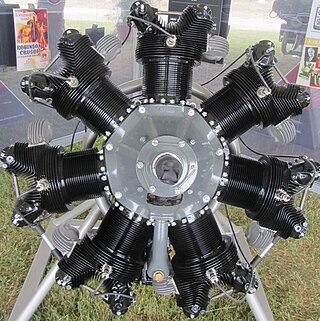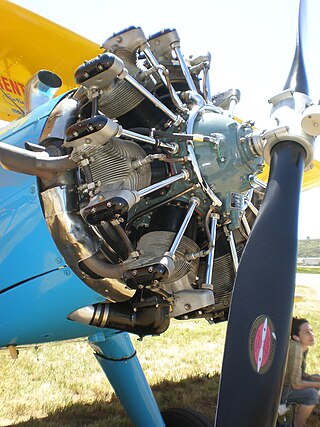
The Centaurus was the final development of the Bristol Engine Company's series of sleeve valve radial aircraft engines. The Centaurus is an 18-cylinder, two-row design that eventually delivered over 3,000 hp (2,200 kW). The engine was introduced into service late in the Second World War and was one of the most powerful aircraft piston engines to see service.

The Armstrong Siddeley Cheetah is a seven-cylinder British air-cooled aircraft radial engine of 834 cu in capacity introduced in 1935 and produced until 1948. Early variants of the Cheetah were initially known as the Lynx Major.

The Armstrong Siddeley Lynx is a British seven-cylinder aero engine developed by Armstrong Siddeley. Testing began in 1920 and 6,000 had been produced by 1939. In Italy Alfa Romeo built a 200 horsepower (150 kW) licensed version of this engine named the Alfa Romeo Lynx.

The Continental R-670 was a seven-cylinder four-cycle radial aircraft engine produced by Continental displacing 668 cubic inches and a dry weight of 465 lb (211 kg). Horsepower varied from 210 to 240 at 2,200 rpm. The engine was the successor to Continental's first radial engine, the 170 hp Continental A-70. This engine was used on many aircraft in the 1930s and 1940s. The R-670 was widely used in the PT-17 Stearman primary training aircraft of the U.S. military.

The Alvis Leonides Major was a British air-cooled 14-cylinder radial aero engine developed by Alvis from the earlier nine-cylinder Leonides.

The Jacobs R-755 is a seven-cylinder, air-cooled, radial engine for aircraft manufactured in the United States by the Jacobs Aircraft Engine Company.

The Gnome-Rhône 7K Titan Major was a seven-cylinder 370 hp (270 kW) air-cooled radial engine, that started life as an enlarged Gnome-Rhône 5K with two extra cylinders.

The Wright R-760 Whirlwind was a series of seven-cylinder air-cooled radial aircraft engines built by the Wright Aeronautical division of Curtiss-Wright. These engines had a displacement of 756 in³ (12.4 L) and power ratings of 225-350 hp (168-261 kW).

The Kinner B-5 was a popular five cylinder American radial engine for light general and sport aircraft of the 1930s.

The Kinner R-5 is an American five cylinder radial engine for light general and sport aircraft of the 1930s.

The Pobjoy Niagara is a British seven-cylinder, air-cooled, radial, aero-engine first produced in 1934. The design ran at higher speeds than conventional engines, and used reduction gearing to lower the speed of the propeller. This led to a noticeable off-centre mounting for the propeller. The Niagara was a popular engine for light and experimental aircraft, well regarded due to its small diameter, smooth operation, low noise and innovative engineering.

The Armstrong Siddeley Cougar was an aero engine developed by Armstrong Siddeley in 1945. The design was a departure from earlier Armstrong Siddeley engines in many ways, it was the company's only nine-cylinder radial design. Although the engine was tested it did not find an aircraft application and was not produced.

The Armstrong Siddeley Deerhound was a large aero engine developed by Armstrong Siddeley between 1935 and 1941. An increased capacity variant known as the Boarhound was never flown, and a related, much larger, design known as the Wolfhound existed on paper only. Development of these engines was interrupted in April 1941, when the company's factory was bombed, and on 3 October 1941 the project was cancelled by the Air Ministry.
The Jacobs R-830 or L-5 is a seven-cylinder, air-cooled, radial engine for aircraft manufactured in the United States, production started in 1935.

The Alvis Pelides was an unflown British air-cooled radial aero engine first developed in 1936. The Pelides Major was a projected but unbuilt development as were the Alcides, Alcides Major and the Maeonides Major, the Alvis aircraft engine range taking their names from Greek mythology.

The Bristol Neptune was a seven-cylinder air-cooled radial engine developed in 1930. It had the same size cylinders as the earlier Mercury and Titan engines, 5.75 in (146 mm) x 6.5 in (165 mm) which gave a displacement of 1,182 cu in and produced a maximum of 320 horsepower (239 kW). The Neptune was effectively a seven-cylinder version of the Titan.

From 1905 to 1915, Alessandro Anzani built a number of three-cylinder fan engines and radial engines, one of which powered Louis Blériot's 1909 cross-channel flight. An Anzani three-cylinder engine that powers a Blériot XI based in England is thought to be the oldest airworthy engine in the world.

Alessandro Anzani developed the first two-row radial from his earlier 3- cylinder Y engine by merging two onto the same crankshaft with a common crankweb.
The RAF 2 was a British air-cooled, nine-cylinder radial engine developed for aircraft use just prior to World War I; it was designed and built by the Royal Aircraft Factory.

The Walter Regulus was a Czechoslovakian five-cylinder, air-cooled radial engine for powering light aircraft that first ran in 1934. The engine produced 186 kW.

















